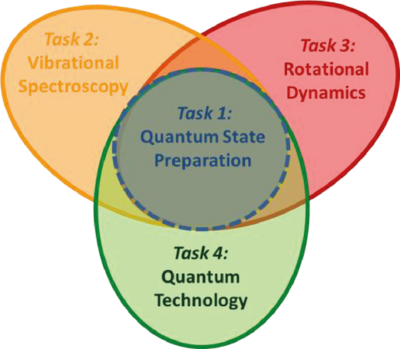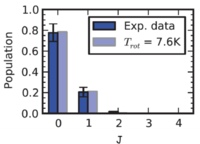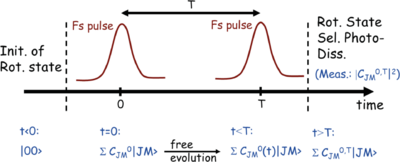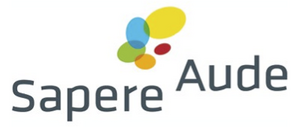The aims of the project are to prepare single molecular ions in their internal as well as external quantum mechanical ground state, and apply modern laser based techniques for precise ro-vibrational state manipulations. With quantum logic spectroscopy, direct measurements of vibrational transitions in molecular ions will be pursued for ultra-precise spectroscopy in the mid-infrared regime, and rotational state dynamics induced by femtosecond laser pulses will be explored for unprecedented control of rotational dynamics of molecular ions. Finally, based on the results of the ro-vibrational investigations, and on theoretical calculations, molecular ions with specific properties of potential interest for quantum technology will be identified and explored. The results will have impact on topics spanning from secondary frequency standards in the mid-infrared as well as the THz regime over target preparation for ultra-cold ion chemistry to quantum information storage and processing.

This task will focus on internal and external quantum state preparation of single molecular ions. The main milestone here will be to construct a new cryogenic linear radiofrequency (rf) trap setup which will enable us to demonstrate very efficient internal rovibrational ground state preparation and effective sympathetic ground state sideband cooling at the same time.

Figure 1: Rotational state distribution of a single MgH+ ion after helium buffer gas cooling at a He-gas pressure of ~10-8 mbar.
In addition to combining and optimizing the already well-proven methods for internal and external state preparation, we plan to explore another technique for internal state preparation based on simultaneously addressing multiple rovibrational transitions in MgH+. In analogy to schemes based on electronic excitations [Viteau2008, Lien2011], we expect to be able to make excitations from all rotational states in the vibrational ground state besides the one at lowest energy, such that the molecular ion will eventually be optically pumped into the rovibrational ground state.
Here, the focus will on extending the technique of so-called Quantum Logic Spectroscopy (QLS) [Schmidt2005], which has led to the most precise frequency measurements in the UV range of electronic transitions in atomic ions [Chou2010a], to direct vibrational transition spectroscopy of molecular ions in the infra-red (IR) to Mid-IR. The basis for such experiments will rotational cooling of single MgH+ ions by either a helium buffer gas at a temperature of 4-10 K (see Fig. 1), or probabilistic state preparation through applying dissociation. Since in the buffer gas cooling case the collision rate is estimated to be only about 10 s-1, it should furthermore be feasible to apply sympathetic sideband cooling under such conditions.
Using a frequency stabilized Quantum Cascade Laser (QCL) optionally in conjunction with a filter cavity, we expect to reach a spectral resolution of ~1 kHz, or a relative uncertainty in the transition frequency of ~10-11. Such measurements will have the multiple aims of providing improved data for quantum chemist to calculate molecular structures at the finest level (including details of rovibrational couplings, as well as fine- and hyperfine structure corrections), and identifying potential secondary frequency standards in the Mid-IR range.
The main objective of this task will be investigations of rotational dynamics induced by fs laser pulses. While rotational levels in molecules are characterized by energy separations corresponding to direct transitions in the far-IR to the mm-wave range, transitions between such levels can be driven by Raman processes where the difference frequency of two optical ones matches the spacing of the rotational levels. Fs lasers can be used to drive such Raman transitions in two regimes: a low pulse energy regime where the fs laser pulses only weakly perturb the energies of the rotational states, and Raman transitions are resonantly driven by sets of “comb teeth”-pairs of a continuously running laser system [Hayes2010]; and a high pulse energy regime where essentially only non-resonant excitations are created by a single intense fs light pulse [Stapelfeldt2003].
In brief, the scheme will rely on applying two identical high energy fs laser pulses separated by a variable time interval, followed by a rotational state selective photodissociation pulse. A bit like in a Ramsey-interferometer, the strength of the dissociation signal vs. the time delay of the second fs pulse will reveal the coherence introduced by the first pulse (see Fig. 2).

Figure 2: Sketch of scheme for detection of rotational dynamics induced by a fs laser pulse at time t=0.
The aim of this task will be to resolve the finest details of the rotational structure, including centrifugal distortions and, e.g., coupling of the rotational degrees of freedom to the fine and hyperfine structures of the electronic structures. For the experimental implementation, the applicant will locally collaborate with both Prof. S. Keiding, Department of Engineering, and Prof. H. Stapelfeldt, Department of Chemistry, at Aarhus University, who have long term experience in handling fs laser systems and investigating fs laser induced rotational dynamics, and will provide the fs laser needed.
The final task is the most exploratory in its nature, and the aims are far less well-defined. The main objective here will be based on the outcome of the other tasks as well as input from the theory to identify molecular ions with particular properties that make them potential candidates as quantum bits, qubits, for ion based quantum computation [Mur-Petit2012]. In comparison to atomic ions, where typically only a very limited number of electronic states are sufficiently stable to be considered as potential qubit states, generally a myriad of rovibrational states in the electronic ground state potential of molecular ions could be considered for defining a qubit. Moreover, by picking molecular ions with specific electronic symmetries one could hope to identify several rovibrational states in a single molecular ion that will have the same properties as decoherence free sub-spaces for pairs of atomic ions [Kielpinski2001], but now localized at a single molecule.
[Viteau2008] M. Viteau, A. Chotia, M. Allegrini, N. Bouloufa, O. Dulieu, D. Comparat, and P. Pillet, Science 321, 232 (2008)
[Lien2011] C. Lien, S. Williams and B. Odom. Physical Chemistry Chemical Physics, 13, 18825-18829 (2011).
[Schmidt2005] P. O. Schmidt, T. Rosenband, C. Langer, W. M. Itano, J. C. Bergquist, and D. J. Wineland, Science 309, 749 (2005).
[Chou2010a] C. W. Chou, D. B. Hume, J. C. J. Koelemeij, D. J. Wineland, and T. Rosenband, Phys. Rev. Lett. 104, 070802 (2010).
[Poulsen2012b] G. Poulsen and M. Drewsen, arXiv:1210.4309.
[Hayes2010] D. Hayes, D. N. Matsukevich, P. Maunz, D. Hucul, Q. Quraishi, S. Olmschenk, W. Campbell, J. Mizrahi, C. Senko, and C. Monroe, Phys. Rev. Lett. 104, 140501 (2010).
[Stapelfeldt2003] H. Stapelfeldt and T. Seideman, Rev. Mod. Phys. 75, 543 (2003).
[Mur-Petit2012] J. Mur-Petit, J. J. Garc?a-Ripoll, J. Perez-Rios, J. Campos-Martinez, M. I. Hernandez, and S. Willitsch, Phys. Rev. A 85, 022308 (2012).
[Kielpinski2001] D. Kielpinski, V. Meyer, M. A. Rowe, C. A. Sackett, W. M. Itano, C. Monroe, and D. J. Wineland, Science 291, 1013 (2001).
The experimental group of former director Joachim Ulrich at the Max-Planck Institute for Nuclear Physics (MPIK), Heidelberg, Germany.
The experimental group Prof. P. Schmidt, Physikalisch-Technische Bundesanstalt (PTB), Braunschweig, and University of Hannover, Germany.
The theory group of Prof. C. Koch, University of Kassel, Germany.
The theory group of Prof. O. Dulieu, Laboratoire Aimé Cotton, Orsay, France.
The experimental group of Prof. S. Keiding, Department of Engineering, Aarhus University
The experimental group of Prof. H. Stapelfeldt, Department of Chemistry, Aarhus University.
Professor Michael Drewsen
Gregers Poulsen
Postdoc 2
Karin Fisher
Jacob Esmann Poulsen
PhD 3
Hansen, A.K., Versolato, O.O., Klosowski, L., Kristensen, S.B., Gingell, A., Schwarz, M., Windberger, A., Ullrich, J., Lopez-Urrutia, J.R.C. & Drewsen, M., "Efficient rotational cooling of Coulomb-crystallized molecular ions by a helium buffer gas" Nature 508, 76–79 (2014)
This project is funded by The Danish Council for Independent Research (DFF) through the research career programme Sapere Aude (Advanced Grant)
